Notes: Individual differences among learners | Child Development and Pedagogy for CTET Preparation - CTET & State TET PDF Download
Variations among individuals in learning are a universal concept that profoundly influences the learning process and outcomes. Learning heavily depends on these differences, and a competent teacher must recognize that each learner is unique. Understanding these individual differences allows for the formulation of appropriate policies. Curriculum design and teaching methods can then be tailored accordingly with this principle in mind.

Individual Differences
Individual differences refer to the variations observed among members of any group in particular characteristics such as language, culture, religion, gender, and attitudes. It is evident that no two persons are exactly alike. Even children born of the same parents or twins differ in various aspects.
The main causes of individual differences can be broadly categorized into heredity (traits inherited from parents) and environment (what is acquired from different cultures, communities, religions, etc.).
Classification of Individual Differences
Individual differences can be classified into two main categories:
- Inherited Traits: Traits that are passed down from parents genetically.
- Acquired Traits: Traits that are learned and developed through the environment, including culture, upbringing, and past experiences.
Each student is a unique individual, differing in cognitive and affective development, social maturity, abilities, motivations, aspirations, learning styles, needs, interests, and potential. Other factors contributing to student differences include innate intelligence, social and economic background, and variations in past learning experiences.
Educators should not aim to narrow the gap between individuals or to equalize their abilities and performance. Instead, they should strive to understand why students are able or unable to learn well and find appropriate ways to support and enhance their learning.
Diversity of Language
India is a land of a large number of languages spoken in various communities. It's not always the case that the language used at home and in the learner's neighborhood is the same as the medium of instruction in school, especially if the language of instruction is English. This disparity can lead to difficulties in reading comprehension and writing skills. Factors contributing to low language proficiency include:
- Not understanding the nature and structure of the language.
- Not comprehending the scope of the language.
- Biases related to caste, creed, race, and gender that are not addressed by teachers.
- Reluctance of teachers to understand the role of the mother tongue in a child’s cognitive development.
Culture, Community, and Religion
Learners from socially and culturally disadvantaged backgrounds, such as Scheduled Castes (SCs) and Scheduled Tribes (STs), often face challenges in academic achievement. It's important to integrate these learners into the mainstream of society.
Gender
Gender differences contribute significantly to individual differences. On average, women show a slight superiority over men in memory, language, and aesthetic sense. Women often excel in social responsibilities but may be more emotionally inclined compared to men.
Family
Even children from the same family, sharing similar genetic traits, can significantly differ in personality due to physical differences, gender, and various environmental factors such as parental treatment and education. These differences impact learning.
Emotion
Emotions play a crucial role in learning. Some individuals exhibit prominent positive emotions like love and affection, while others may experience more powerful negative emotions. Emotional stability significantly influences learning outcomes.
Physical Differences
Individuals differ in various physical attributes such as height, weight, skin color, eye and hair color, facial features, and mannerisms. These physical differences can affect learning outcomes.
Attitude
Research indicates that individuals vary in attitudes, affecting their cognitive and affective responses. Those with structured attitudes tend to have faster emotional and cognitive responses compared to those with less structured attitudes.
Personality
Personality and social behavior vary among individuals due to genetic and environmental factors. This variation significantly impacts learning outcomes.
Aptitude, Intelligence, and Acquisition of Core Skills
Individuals possess different aptitudes and intellectual abilities, influencing their learning of specific skills. Aptitude, intelligence, and core skill acquisition are influenced by factors such as general intelligence, procedural understanding speed, and psychomotor abilities.
Importance of Understanding Individual Differences in Education
It is crucial for teachers to understand individual differences so that they can create a learning environment that accommodates learners’ physical and socio-cultural diversity. Effective learning requires teachers to address the differences within a classroom, including psychological, personal, social, religious, and other factors.
Methods for Addressing Individual Differences
- Grouping Children: Divide children into groups for classroom activities, ensuring each group consists of learners with diverse cultures and talents.
- Adapted Curriculum: Develop a curriculum that accommodates learners’ individual differences. Implement teaching-learning strategies tailored to meet the individual needs of students, which enhances learning outcomes.
- Consider Physical Differences: Take into account the physical differences between learners and manage the classroom environment to provide optimal learning opportunities for all students.
|
67 videos|154 docs|41 tests
|





















